Spf
Google, Alignment and DMARC
Google has been making a number of changes to their systems over the last few weeks. Folks are seeing a lot of changes in Google postmaster tools and they’re seeing changes in how Google is displaying headers in the “show original” tab.
Read MoreDo we care about SPF alignment?
SPF and DKIM are the two main ways we associate a domain name with a stream of email in an authenticated way. We can choose the DKIM signing domain fairly freely – we can choose any domain or subdomain we control and put it in the d= field of the DKIM signature. But our choice for the SPF domain is more constrained.
Read MoreSending domains and hostnames
Lots of times I see someone asking a question and they talk about their sending domain. And it’s sometimes not 100% clear which domain they mean by that – and when we’re talking about alignment and reputation it can make a difference. So here’s a list of (some of?) the different places a mailserver uses a domain.
Read MoreDMARC: The good, the bad and the ugly

DMARC is the newest of the authentication protocols. It compares the domain in the From: address to the domains authenticated by SPF and DKIM. If either SPF or DKIM pass and they are in the same organizational domain as the domain in the From: address then the email is authenticated with DMARC.
Read MoreDNS for white label authentication with SproutDNS
I wrote last year about using “stunt” nameservers for customer subdomain authentication – i.e. dynamically generating all the authentication records needed in DNS for each customer as needed.
Read MoreCustomer subdomain authentication
EDIT: Now with a production-ready implementation I talk about more here.
Read MoreWildcards and DKIM and DMARC, oh my!
If you’re an ESP with small customers you may have looked at the recent Google / Yahoo requirements around DMARC-style alignment for authentication and panicked a bit.
Read MoreThe trouble with CNAMEs
When you query DNS for something you ask your local DNS recursive resolver for all answers it has about a hostname of a certain type. If you’re going to a website your browser asks your resolver for all records for “google.com” of type “A”1or “AAAA”, but that’s not important right now and it will either return all the A records for google.com it has cached, or it will do the complex process of looking up the results from the authoritative servers, cache them for as long as the TTL field for the reply says it should, then return them to you.
Read MoreStop with the incorrect SPF advice
Another day, another ESP telling a client to publish a SPF include for the wrong domain. It shouldn’t annoy me, really. It’s mostly harmless and it’s just an extra DNS look up for most companies. Heck, we followed Mailchimp’s advice and added their include to our bare root domain and it’s not really a huge deal for companies with only a couple SaaS providers. Still, it’s an incorrect recommendation and it does cause problems for some senders who are using multiple SaaS providers and Google.
Read MoreSome Microsoft thoughts
Right at the end of January, Microsoft appears to have made couple of changes to how they’re handling authentication. The interesting piece of this is that, in both cases, Microsoft is taking authentication protocols and using them in ways that are slightly outside the spec, but are logical extensions of the spec.
Read MoreCost of authentication
At the end of last year, Steve wrote a post about the different types of authentication. I thought I’d build on that and write about the costs associated with each type. While I know a lot of my readers are actually on the sending side, I’m also going to talk about the costs associated with the receiving side and a little bit about the costs for intermediaries such as CRM systems or ESPs.
Read MoreAuthentication
Some notes on some of the different protocols used for authentication and authentication-adjacent things in email. Some of this is oral history, and some of it may be contradicted by later or more public historical revision.
Read MoreIdentifying domains that don’t accept or send email
A couple folks have asked me recently about MX records that they don’t understand. These records consist of a single . or they contain localhost or they are 127.0.0.1.
Read MoreMicrosoft and SPF
Many deliverability folks stopped recommending publishing SPF records for the 5322.from address to get delivery to Microsoft. I even remember Microsoft saying they were stopping doing SenderID style checking. A discussion on the emailgeeks slack channel has me rethinking that.
Read MoreWhy is DMARC failing?
Multiple times over the last few weeks folks have posted a screenshot of Google Postmaster tools showing some percentage of mail failing DMARC. They then ask why DMARC is failing. Thanks to how DMARC was designed, they don’t need to ask anyone this, they have all the data they need to work this out themselves.
Read MoreNull sender address
A question came up on the email geeks slack channel about empty from addresses. I asked if they meant the 5321 or 5322 from address which prompted a question about if you could even have a null 5321 from.
Read MoreSenderID is dead
A question came up on the email geeks slack channel (Join Here) about SenderID. They recently had a customer ask for SenderID authentication.
Read MoreWhat SPF records should you publish?
When it comes to SPF records there seems to be a lot of confusion. I mean, a decade after I posted it Authenticating SPF is still the most frequently visited post on the site. And, of course, there are hundreds of other pages out there that discuss SPF and what to publish. Still, there are common questions.
Read MoreSPF and TXT records and Go
A few days ago Laura noticed a bug in one of our in-house tools – it was sometimes marking an email as SPF Neutral when it should have been a valid SPF pass. I got around to debugging it today and traced it back to a bug in the Go standard library.
Read MoreAuthentication is about Identity, not Virtue
I just got some mail claiming to be from “Bank of America <secure@bofasecure.com>”.
It passes SPF:
The feds are deploying DMARC
The US National Cybersecurity Assessments & Technical Services Team have issued a mandate on web and email security, including TLS+HSTS for web servers, and STARTTLS+SPF+DKIM+DMARC for email.
It’s … pretty decent for a brief, public requirements doc. It’s compatible with a prudent rollout of email authentication.
Are they using DKIM?
It’s easy to tell if a domain is using SPF – look up the TXT record for the domain and see if any of them begin with “v=spf1”. If one does, they’re using SPF. If none do, they’re not. (If more than one does? They’re publishing invalid SPF.)
AOL are publishing SPF. Geocities aren’t.
For DKIM it’s harder, as a DKIM key isn’t published at a well-known place in DNS. Instead, each signed email includes a “selector” and you look up a record by combining that selector with the fixed string “._domainkey.” and the domain.
If you have DKIM-signed mail from them then you can find the selector (s=) in the DKIM-Signature header and look up the key. For example, Amazon are using a selector of “taugkdi5ljtmsua4uibbmo5mda3r2q3v”, so I can look up TXT records for “taugkdi5ljtmsua4uibbmo5mda3r2q3v._domainkey.amazon.com“, see that there’s a TXT record returned and know there’s a DKIM key.
That’s a particularly obscure selector, probably one they’re using to track DKIM lookups to the user the mail was sent to, but even if a company is using a selector like “jun2016” you’re unlikely to be able to guess it.
But there’s a detail in the DNS spec that says that if a hostname exists, meaning it’s in DNS, then all the hostnames “above” it in the DNS tree also exist (even if there are no DNS records for them). So if anything,_domainkey.example.com exists in DNS, so does _domainkey.example.com. And, conversely, if _domainkey.example.com doesn’t exist, no subdomain of it exists either.
What does it mean for a hostname to exist in DNS? That’s defined by the two most common responses you get to a DNS query.
One is “NOERROR” – it means that the hostname you asked about exists, even if there are no resource records returned for the particular record type you asked about.
The other is “NXDOMAIN” – it means that the hostname you asked about doesn’t exist, for any record type.
So if you look up _domainkey.aol.com you’ll see a “NOERROR” response, and know that AOL have published DKIM public keys and so are probably using DKIM.
(This is where Steve tries to find a domain that isn’t publishing DKIM keys … Ah! Al’s blog!)
If you look up _domainkey.spamresource.com you’ll see an “NXDOMAIN” response, so you know Al isn’t publishing any DKIM public keys, so isn’t sending any DKIM signed mail using that domain.
This isn’t 100% reliable, unfortunately. Some nameservers will (wrongly) return an NXDOMAIN even if there are subdomains, so you might sometimes get an NXDOMAIN even for a domain that is publishing DKIM. shrug
Sometimes you’ll see an actual TXT record in response – e.g. Yahoo or EBay – that’s detritus left over from the days of DomainKeys, a DomainKeys policy record, and it means nothing today.
The philosophy of DMARC
We know that legitimate email sent with valid SPF and a DKIM signature often breaks in transit.
SPF will fail any time mail is forwarded – via a mailing list, a forwarding service used by the recipient, or just ad-hoc forwarding.
DKIM will fail any time the message is modified in transit. That can be obviously visible changes, such as a mailing list tagging a subject header or adding a footer to the body. It can also be less obvious changes, such as intermediate MTAs wrapping lines that are too long, reencoding content or repackaging the message altogether – perhaps when delivering from a mailserver that is 8BITMIME compliant to one that isn’t.
(This image has absolutely nothing to do with email authentication, but searching for stock photography about email or authentication or chains or, well, pretty much anything like that leads to horribly depressing corporate imagery. So, no. Have something colourful and optimistic instead.)
As SPF and DKIM are typically used, none of this is much of a problem. A message being authenticated provides a little extra information to the receiving mailserver, and the domain attached to the authentication can be used to look up a senders reputation, giving a potential boost to the chances of the mail being sent to the inbox. If the authentication is broken, though, the mail will still be judged on it’s merits – is it coming from an IP address that’s a source of good mail, does the content look legitimate, and all the other things a spam filter looks at.
That authentication is a (potentially big) positive signal, but lack of authentication isn’t really any signal at all is why SPF and DKIM being fragile wasn’t an issue. SPF and DKIM are positive assertions – “IF this mail IS authenticated THEN IT IS from me”.
That changed when DMARC became popular, though.
DMARC allows the owner of a domain to say “We send no mail that is not authenticated, and we promise that none of that authentication will be broken in transit”. DMARC is a negative assertion – “IF this mail IS NOT authenticated THEN it IS NOT from me”. It converts the absence of a positive assertion into a negative assertion.
This isn’t the first attempt to layer a “we authenticate everything” negative assertion on top of fragile email authentication. SPF did it, with the -all flag (which is universally ignored, leaving SPF purely as a positive assertion). DomainKeys did it, with DomainKeys policy records (which you occasionally still see published, but were never really used to reject mail). DKIM did it with ADSP – which didn’t see much use either.
The reason none of them were used much is because even when senders were telling the truth about “we send no email that is not authenticated” they were always lying, to varying degrees, about “none of the authentication will be broken in transit”.
If your domain that is solely used for bulk email. If it’s never for used mail sent by human beings, not even customer support employees. If it’s a newly created domain with no legacy usage that only sends email from a very tightly controlled infrastructure. If you only send email that’s been created via a well implemented message composition pipeline that ensures the content of the is not just RFC compliant but also “well formed”, with short lines, simple widely implemented encoding, vanilla mime structure and so on. And it’s sent out via conservatively configured smarthosts that deliver directly to the end recipients MX. And if you know that the demographics of your recipients are such that the minority that are forwarding that mail elsewhere (e.g. from their Yahoo account to their Google account or via an alumni mail alias) is a small enough group that you don’t care about them…
If all of those things are true, then your domain is going to be able to deploy DMARC pretty easily and safely. If not, though, how can you tell?
That’s the place where DMARC improves over it’s predecessors. It allows you not only to publish a DMARC policy record in test mode, so it’s not actually used to filter your mail (well, mostly, but that’s a longer story) but also to ask recipients to notify you of mail that seems to be from you but which isn’t authenticated.
You can publish a “p=none” DMARC record with notification addresses in it and wait and see what happens. You’ll get notification of mail that has your domain in the From: field but which isn’t authenticated.
As a first round of action that lets you see where you’re sending email from that you didn’t know about. Sysadmin notification email. That marketing splinter group in Sasketchwan. The outsourced survey company.
Once you’ve cleaned all that up, and made sure everyone is authenticating their mail then you can look at what’s left. The next step is likely to be mistakes you’re making in authentication or message composition that’s causing some of your mail – typically depending on content, and source and recipient domain – to become unauthenticated. Clean that up, make sure all your message composition is squeaky clean, make sure employees aren’t sending mail using that domain in ways you don’t authorize (interacting with mailing list, for example).
By that point you’ll have reduced the torrent of reports you’re getting to two types. One is mail that you send that has it’s authentication broken in transit through some process you have no control over. The other type is mail that has your domain in the “From” field but which you didn’t send. Some of that may be legitimate use of your domain by your employees, such as forward-to-a-friend services, signing up for document delivery via email, third-party notification services. By deploying DMARC you are declaring all that sort of usage to be illegitimate, and you’ll need to get all your employees to stop doing it (or, at least, know that it’s going to stop working). The rest of it is likely a mix of spam and phishing mail. The spam, that’s just using your domain in random from addresses, you probably don’t care about. The phishing you do.
You’ve finally cleaned up your mail infrastructure and policies enough to gather the data you need. How much of my legitimate email will have it’s authentication broken (and hence be silently thrown away by DMARC)? And how much hostile phishing mail is targeting my users (and using the exact domain you are)?
Then you have the information you need to make an informed decision as to how badly deploying DMARC will break your legitimate use of email (after you’ve done everything you can to minimize that) and some idea of whether it will provide you any benefit, at least in the shorter term.
That testing phase, where senders can use other peoples mail infrastructure to investigate their sending practices, gradually fix any problems and finally gather some metrics is what made gave the developers of the DMARC spec confidence that it wouldn’t break things, and made it much more deployable than previous approaches to negative assertion.
On Monday, how all that optimistic reasoning went to hell, what it broke and how we’re trying to fix it.
Tools!
I just added a DMARC validation tool over on tools.wordtothewise.com.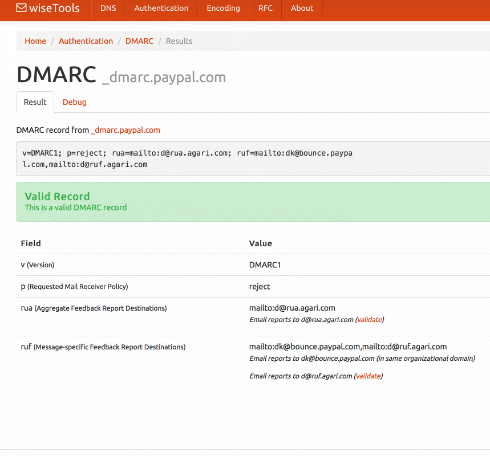
You can give it a domain – such as ebay.com – and it will fetch the DMARC record, then explain and validate it. Or you can paste the DMARC record you’re planning to publish into it, to validate it before you go live.
If you’ve not seen our tools page before, take a look. As well as DMARC we have a DKIM validator, SPF expander and optimizer, general DNS lookup tools, a bunch of RFCs covering all sorts of protocols, and base64 and quoted-printable decoders.
There’s also a widget that lets you add those little unicode pictures to your subject lines, whether you need a snowman ⛄, a forest ????, or a pig getting closer ???.
The results pages all have easily copyable URLs so they’re pretty good for sharing with co-workers or customers if you need that sort of thing.
(And if you need a cidr calculator, whois, or easy access to abuse.net & Microsoft SNDS check out Al’s xnnd.com.)
Fun with opinions
Over the last few weeks I’ve seen a couple people get on mailing lists and make pronouncements about email. It’s great to have opinions and it’s great to share them. But they’re always a little bit right… and a little bit wrong.
Gmail showing authentication results to endusers
A bit of older news, but worth a blog post. Early in August, Gmail announced changes to the inbox on both the web interface and the android client. They will be pushing authentication results into the interface, so end users can see which emails are authenticated.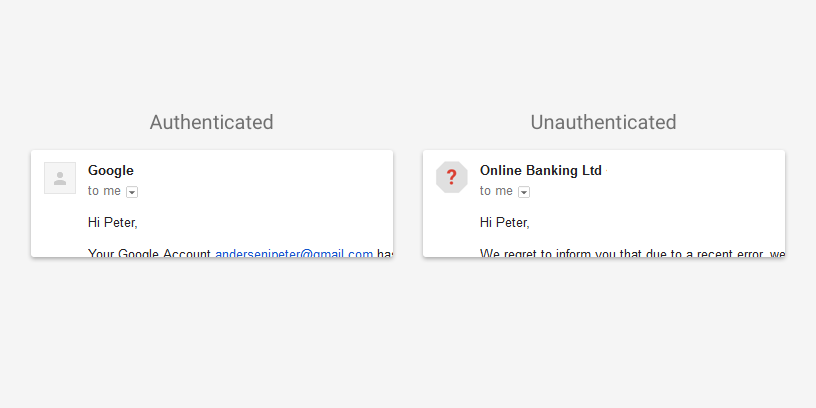
These are not deliverability changes, the presence or absence of authentication will not affect inbox delivery. And the gmail Gmail support pages clarify that lack of authentication is not a sign that mail is spam.
This isn’t a huge change for most ESPs and most senders. In fact, Gmail has reported more than 95% of their mail is authenticated with either SPF or DKIM. Now, Gmail does a “best guess” SPF – if it looks like an IP should be authorized to send mail for a domain (like the sending IP is the same as the MX) then it’s considered authenticated.
It’s good to see authentication information being passed to the end user.
BT Internet
I’ve been seeing reports for the last few weeks that a lot of folks are having problems getting mail into BT Internet. Many people are reporting the response
Read MoreJuly 2016: The Month in Email
We got to slow down — and even take a brief vacation — in July, but we still managed to do a bit of blogging here and there, which I’ll recap below in case you missed anything.
At the beginning of the month, I wrote about email address harvesting from LinkedIn. As you might imagine, I’m not a fan. A permissioned relationship on social media does not equate to permission to email. Check out the post for more on mailing social media contacts.
Even people who are collecting addresses responsibly can face challenges. One of the most important challenges to address is paying attention to your existing subscription processes, testing them regularly, evaluating effectiveness and optimizing as needed.
Our most commented-upon post this month was a pointer to a smart writeup about Hillary Clinton’s email server issues. Commenters were pretty evenly split between those who agreed that they see this kind of workaround frequently, and those who felt like regulatory processes do a good job managing against this kind of “shadow IT” behavior. I wrote a followup post on why we see this kind of workaround frequently in email environments, even in regulated industries, and some trends we’re seeing as things improve.
In other election-related email news, we saw the challenges of campaign email being flagged as spam. As I pointed out, this happens to all campaigns, and is nothing unique to the Trump campaign. Still, there are important lessons for marketers here, too, in terms of list management, email content, frequency, and engagement — all of which are inextricably linked to deliverability.
Speaking of spam and engagement, Steve took a look at some clickthrough tracking revealed through a recent spam message I received — and why legitimate marketers should avoid using these sorts of URL referrers.
On the topic of authentication, I wrote a quick post about how seeing ?all in the SPF record tells me one thing: the person managing the record isn’t doing things properly. Need a refresher on authentication? Our most-read blog post of all time can help you out.
And as always, send me your interesting questions and I’ll be happy to consider them as I resume my Ask Laura column in August.
SPF ?all
The most read post on the blog is Authenticating with SPF: -all or ~all. In fact, it’s in the top 5 posts every single day. We still get comments on it, too. Usually from folks who disagree with my recommendations.
I still stand by my recommendations, though. It doesn’t really matter if you choose ~all or -all in your SPF records. Why? No major provider is rejecting mail solely because of a SPF fail. They may bulk the mail, but they won’t reject it. That’s why, in a deliverability context, it doesn’t matter which one you choose.
My one rule for SPF is never use ?all. Just. No. In the spec, ?all is “testing” mode. But it really is a signifier that the person who put the SPF record together doesn’t know what they’re doing. Unless they really are testing, but even then you shouldn’t see ?all on records for weeks or months.
~ or – never ?
Don't just follow the HOWTO
![]() There are so many moving parts to ensure good email deliverability. Email marketers need to know marketing, they need to know email and they need to know design. The technical bits of email can be a challenge to learn, and many folks who write tutorials and How-Tos write them for a different audience than marketers.
There are so many moving parts to ensure good email deliverability. Email marketers need to know marketing, they need to know email and they need to know design. The technical bits of email can be a challenge to learn, and many folks who write tutorials and How-Tos write them for a different audience than marketers.
One of the things I’m trying to do is demystify the technical end of email for marketers. Today I talked about authentication in the Only Influencers newsletter. Check it out!
Understanding the technical: Authentication
Authentication in general
Ask Laura: Can you help me understand no auth / no entry?

Dear Laura,
I’m a little confused by the term “no auth / no entry”. Gmail and other major receivers seem to be moving towards requiring authentication before they’ll even consider delivery.
Does this just mean SPF and DKIM, or does this mean the much more stringent DMARC, as well?
Thanks,
No Shirt, No Shoes, No What Now?
March 2016: The Month In Email
Happy April! I’m just back from the EEC conference in New Orleans, which was terrific. I wrote a quick post about a great session on content marketing, and I’ll have more to add about the rest of the conference over the next week or so. Stay tuned!
Here’s a look at what caught our attention in March:
On the DMARC front, we noted that both Yahoo and mail.ru are moving forward with p=reject, and Steve offered some advice for ESPs and software developers on methods for handling this gracefully. I also answered an Ask Laura question about making the decision to publish DMARC. Look for more on that in this month’s Ask Laura questions…
Our other Ask Laura question this month was about changing ESPs, which senders do for many reasons. It’s useful to know that there will generally be some shifts in deliverability with any move. Different ESPs measure engagement in different ways, and other issues may arise in the transition, so it’s good to be aware of these if you’re contemplating a change.
In industry news, I wrote a sort of meta-post about how the Internet is hard (related: where do you stand on the great Internet vs. internet debate? Comment below!) and we saw several examples of that this month, including a privacy debacle at Florida State University. Marketing is hard, too. I revisited an old post about a fraud case where a woman sued Toyota over an email marketing “prank”. As always, my best practices recommendation for these sorts of things (and everything else!) really boils down to one thing: send wanted email.
Steve wrote extensively about SPF this month in two must-read posts, where he explained the SPF rule of ten and how to optimize your SPF records. He also wrote about Mutt, the much-loved command line email client, and marked the passing of industry pioneer Ray Tomlinson, who, in addition to his many accomplishments, was by all accounts a very thoughtful and generous man.
Finally, I occasionally like to take a moment and follow the twisty paths that lead to my spam folder. Here’s a look at how Ugg spams my email doppelganger, MRS LAURA CORBISHLEY. In other spam news, there’s a lot of very interesting data in the recent 10 Worst list from Spamhaus. Take a look if you haven’t seen it yet.
Optimize your SPF records
I talked on Monday about the SPF rule of ten and how it made it difficult for companies to use multiple services that send email on their behalf.
Today I’m going to look at how to fix things, by shrinking bloated SPF records. This is mostly aimed at those services who send email on their customers behalf and ask their customers to include an SPF record as that’s the biggest pain point, but some of it is also useful to people publishing their own SPF records.
Get rid of costly SPF directives
First, rethink using the “mx” directive. It’s often used in example SPF records, because it makes them look simpler. But an MX directive always triggers a DNS lookup that counts against your limit of ten, and it’ll also trigger a DNS lookup for each hostname in your MX record – they don’t count against the SPF limit but may increase the latency of your delivery a little. Better than using “mx” is to use explicit “ip4” and “ip6” records to list the addresses your smarthost and MX send mail from. Even though this makes your SPF record look longer it’ll actually make it smaller, as measured by DNS queries, as a single “mx” directive costs more than 20 “ip4” directives.
Similarly, avoid the “a” directive. It’s much less commonly seen but again can usually be replaced with “ip4” or “ip6” directives.
Don’t use “ptr” directives. They’re deprecated by the current SPF RFC.
Check the address ranges
If you have many “ip4” and “ip6” directives, make sure they’re not redundant. Are there any address ranges that you’re not using any more? Are there any adjacent address ranges that can be merged? For example, “ip4:x.y.z.4/24” and “ip4:x.y.z.5/24” can be replaced with “ip4:x.y.z.4/23” (note that you can’t always replace adjacent address blocks of the same size – read up on CIDR notation).
If you’ve generated your CIDR blocks from address ranges you can sometimes have very inefficient representations. The address range 10.11.12.1-10.11.12.254 needs 14 “ip4” directives to represent precisely. Instead you can use the single directive “ip4:10.11.12.0/24”, even if you’re not sending any email from the .0 or .255 addresses.
You don’t need a “~all” or “-all” at the end of a TXT record that is only included in another SPF record, not used directly. It won’t do any harm but it wastes a few characters.
Once you’ve got your list of SPF directives cleaned up the next thing to do is to pack them into one or more DNS TXT records.
Use as few TXT records as you can
Some SPF tutorials say that you can’t put more than 255 characters of SPF data into each TXT record. That’s not quite true, though.
A TXT record contains one or more strings of text and each string can contain no more than 255 characters. But an SPF checker will take all of the strings in a TXT record and concatenate them together in order before it starts looking at the content. So you can have more than 255 characters of SPF data in a TXT record by splitting it into more than one string. (Some low-end DNS management web front ends don’t really understand TXT records and won’t let you include multiple strings – you should check that your DNS management system does before relying on this).
How much more than 255? That’s where you have to get a little familiar with the DNS protocol, as the real limitation is that you don’t want your DNS packets to be more than 512 bytes long. (Why 512 bytes? That’s a long story of protocol changes and incompatibility, but 512 bytes are about as big as you can reliably use over UDP. Just trust me.)
The DNS overhead for a reply that contains a single TXT record with two strings is about 34 bytes, plus the length of the hostname that’s being queries (e.g. “spf.example.com” is 15 bytes). So to keep within the 512 byte limit you need to break your SPF into chunks of no more than 478 minus the length of the hostname. Then you need to break that SPF data into two strings (remembering that they’ll be concatenated with no white space added, so if you break it at a space you need to include the space at the end of the first string or the beginning of the second).
That’ll give you a TXT record that looks something like this:
SPF: The rule of ten
Some mechanisms and modifiers (collectively, “terms”) cause DNS queries at the time of evaluation, and some do not. The following terms cause DNS queries: the “include”, “a”, “mx”, “ptr”, and “exists” mechanisms, and the “redirect” modifier. SPF implementations MUST limit the total number of those terms to 10 during SPF evaluation, to avoid unreasonable load on the DNS. If this limit is exceeded, the implementation MUST return “permerror”.
Read More
Should you publish DMARC?
 I’ve been hearing a lot lately about DMARC. Being at M3AAWG has increased that. Last night we were at dinner and heard from the next table “And they’re not even publishing DMARC!!!!”
I’ve been hearing a lot lately about DMARC. Being at M3AAWG has increased that. Last night we were at dinner and heard from the next table “And they’re not even publishing DMARC!!!!”
I know DMARC is the future. I know folks are going to have to start publishing DMARC records. I also know that the protocol is the future. I am also not sure that most companies are ready for DMARC.
So lets take a step back and talk about DMARC, what it is and why I’m still a little hesitant to jump on the PUBLISH DMARC NOW!! bandwagon.
What to expect in 2016
 I don’t always do predictions posts, even though they’re popular. Most years I skip them because I don’t see major changes in the email space. And, I’m not the type to just write a prediction post just to post a prediction.
I don’t always do predictions posts, even though they’re popular. Most years I skip them because I don’t see major changes in the email space. And, I’m not the type to just write a prediction post just to post a prediction.
This year, though, I do see changes for everyone in the email space. Most of them center on finally having to deal with the technical debt that’s been accumulating over the past few years. I see ISPs and ESPs spending a lot of development effort to cope with the ongoing evolution authentication requirements.
When people started seriously looking at how to authenticate email, the first goal was getting organizations to implement the protocols. This was a practical concession; in order for a new protocol to be used it needs to be widely implemented. Phase one of authenticating email was simply about publishing protocols and getting organizations to use them.
During phase one, the organization that authenticated a mail hasn’t been important. In fact, the SPF spec almost guarantees that the ESP domain is the authenticated domain. In DKIM, the spec says any domain could sign as long as they could publish a public key in that domain’s domainkeys record.
ESPs took full advantage of this and lowered their own development overhead by taking most of the authentication responsibility on themselves. Their domains were in the 5321.from and they published the SPF records. Domains they control were in the d= and they generated and published the DKIM keys. Mail was authenticated without ESP customers having to do much.
We’ve hit the end of phase one. Most of the major players in the email space are authenticating outbound email. Many of the major players are checking authentication on the inbound. Phase one was a success.
We’re now entering phase two, and that changes thing. In phase two, SPF and DKIM are used as the foundation for user visible authentication. Neither SPF nor DKIM were designed to be user visible protocols. To understand what they’re authenticating you have to understand SMTP and email. Even now there are days when I begin talking about one of them and have to take a step back and think hard about what is being authenticated. And I use these things every day!
DMARC is the first of these end user visible protocols built on SPF and DKIM. It uses the established and widespread authentication to validate the user visible from address. This authentication requires that the d= value or the 5321.from address belong belong to the same domain in the visible from address. While you can pick whether the alignment between the visible from and the authentication is “strict” or “relaxed” you have no choice about the alignment.
Prior to DMARC no one really paid much attention to the domain doing the authentication. Authentication was a yes or a no question. If the answer was yes, then receivers could use the authenticated domain to build a reputation. But they weren’t really checking much in the way of who was doing the authentication.
In the push to deploy authentication, ESPs assumed the responsibility for authentication deployed ESPs took the responsibility and did most of the work. For many or most customers, authentication was as simple as clicking a checkbox during deployment. Some ESPs do currently let customers authenticate the mail themselves, but there’s enough overhead in getting that deployed that they often charged extra to cover the costs.
DMARC is rapidly becoming an expectation or even a full on requirement for inbox delivery. In order to authenticate with DMARC, the authenticating domain must be in the same domain space as the visible from. If senders want to use their own domain in the visible from, DNS records have to be present in that domain space. Whether it’s a SPF TXT record or a domainkeys record the email sender customer needs to publish the correct information in DNS. Even now, if you try to authenticate with DKIM through google apps, they require you to publish DNS records.
ESPs aren’t in a situation where they can effectively manage authentication alignment for all their customers. Hosting companies are in even worse shape when it comes to letting customers authenticate email. Developers are facing the fact they need to go back and rework their authentication code. Businesses are facing the fact they need to change their processes so customers can authenticate with DMARC.
It’s not just the infrastructure providers that are facing challenges with authentication. Senders are going to discover they can no longer hand authentication off to their ESPs and not worry about it. They’re going to have to get DNS records published by their own staff.
Getting DNS updates through some big companies is sometimes more difficult than it should be. I had one client a few years ago where getting rDNS changed to something non-generic took over a month. From an IT standpoint, changing DNS should require approvals and proper channels. Marketers may find this new process challenging.
And, if organizations want to publish reject policies for their domains, then they will have to publish records for every outside provider they use. Some of those providers can’t support DMARC alignment right now.
In 2016 a lot of companies will discover their current infrastructure can’t cope with modern authentication requirements. A lot of effort, both in terms of product development and software development, will need to be spent to meet current needs. This means a lot of user visible features will be displaced while the technical debt is paid.
These changes will improve the security and safety of email for everyone. It won’t be very user visible, which will give the impression this was a slow year for email development. Don’t let that fool you, this will be a pivotal year in email.
SPF debugging
Someone mentioned on a mailing list that mail “from” intuit.com was being filed in the gmail spam folder, with the warning “Our systems couldn’t verify that this message was really sent by intuit.com“. That warning means that Gmail thinks it may be phishing mail. Given they’re a well-known financial services organization, I’m sure there is a lot of phishing mail claiming to be from them.
But I’d expect that a company the size of Intuit would be authenticating their mail, and that Gmail should be able to use that authentication to know that the mail wasn’t a phish.
Clearly something is broken somewhere. Lets take a look.
Looking at the headers, the mail was being sent from Salesforce, and (despite Salesforce offering DKIM) it wasn’t DKIM signed by anyone. So … look at SPF.
SPF passes:
IPv6 and authentication
I just saw a post over on the mailop mailing list where someone had been bitten by some of the IPv6 email issues I discussed a couple of months ago.
They have dual-stack smarthosts – meaning that their smarthosts have both IPv4 and IPv6 addresses, and will choose one or the other to send mail over. Some domains they send to use Office 365 and opted-in to receiving mail over IPv6, so their smarthosts decided to send that mail preferentially over IPv6.
The mail wasn’t authenticated, so it started bouncing. This is probably going to happen more and more over the next year or so as domain owners increasingly accept mail over IPv6.
If your smarthosts are dual stack, make sure that your workflow authenticates all the mail you send to avoid this sort of delivery issue.
One mistake I’ve seen several companies make is to have solid SPF authentication for all the domains they send – but not for their IPv6 address space. Check that all your SPF records include your IPv6 ranges. While you’re doing that keep in mind that having too many DNS records for SPF can cause problems, and try not too bloat the SPF records you have your customers include.
Check your tech
One of the things we do for just about every new client coming into WttW is have them send us an email from their bulk mail system. We then check it for technical correctness. This includes things like reviewing all the different From headers, rDNS of the connecting IP, List-Unsubscribe headers and authentication. This is always useful, IMO, because we often find things that were right when they were set up, but due to other changes at the customer they’re not 100% correct any more.
This happens to most of us. Even a company as small as Word to the Wise misses a rDNS update here or a hostname change update there when making infrastructure changes. That’s even when the same people know about email and are responsible for the infrastructure.
One of the most common problems we see is a SPF record that has accumulated include: files from previous providers. There are a couple reasons for this. One is the fact that SPF is set up while still at the old provider in anticipation of moving to the new provider. Once the move is made no one goes back to clean up the SPF record and remove the old entries. The other reason is that a lot of tech folks don’t like to delete things. Deleting things can lead to problems, and there’s no harm in a little extra in the SPF record. Except, eventually, there are so many include files that the lookup fails.
Every mailer should schedule a regular tech audit for their mail. Things change and sometimes in the midst of chance we don’t always catch some of the little details.
TXTing
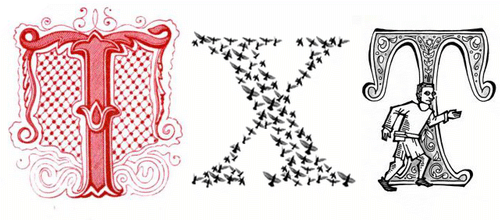
On Friday I talked a bit about the history behind TXT records, their uses and abuses.
But what’s in a TXT record? How is it used? When and where should you use them?
Here’s what you get if you query for the TXT records for exacttarget.com from a unix or OS X command line with dig exacttarget.com txt
A brief history of TXT Records

When the Domain Name System was designed thirty years ago the concept behind it was pretty simple. It’s mostly just a distributed database that lets you map hostname / query-type pairs to values.
If you want to know the IP address of cnn.com, you look up {cnn.com, A} and get back a couple of IP addresses. If you want to know where to send mail for aol.com users, you look up {aol.com, MX} and you get a set of four hostname / preference pairs back. If you want to know the hostname for the IP address 206.190.36.45 you look up {45.36.190.206.in-addr.arpa, PTR} and get a hostname back.
There’s a well-defined meaning to each of those query types – A is for IP addresses, MX is for mailservers, PTR is for hostnames – and that was always the intent for how DNS should work.
When DNS was first standardized, though, there was one query type that didn’t really have any semantic meaning:
What is the Mail From field?
When emails are sent, there are two from fields, the Mail From and the Display From address. The Display From address (technically referred to as RFC.5322 from address) is the from address that is displayed to the end user within their email client. The Mail From (technically referred to as RFC.5321 from address) is the email address to which bounce messages are delivered. The Mail From field is sometimes referred to as the Return Path address, Envelope From address, or Bounce address.
It may seem confusing to have an email with two from fields, but knowing the difference is important to properly setup your SPF records.
Taking a look at this email I received from GoPro, the Return-Path (5321.From) goes back to @bounce.email.gopro.com. If I were to reply to the email, the message would go to @email.gopro.com. The Display From (5322.From) address is gopro@email.gopro.com.
I would want to add the email address GoPro@email.gopro.com to my address book because that is the email address that is displayed in my email client. The reason why the Return-Path is different from the From address is because GoPro likely has an automated system that will process the bounce back messages (sent to @bounce.email.gopro.com) and automatically flag or unsubscribe those email addresses. This allows GoPro to setup automatic processing of the different mail streams sent to them, one stream being the bounce backs after a mailing and the second being an automated customer service system.
Where does SPF fit in?
SPF checks the Mail From (5321.From) address, not the Display From (5322.From) address. In the example above, there should be an SPF record for the subdomain of bounce.email.gopro.com. I can check the SPF record using our Authentication tools http://tools.wordtothewise.com/spf/check/bounce.email.gopro.com and I receive the following results: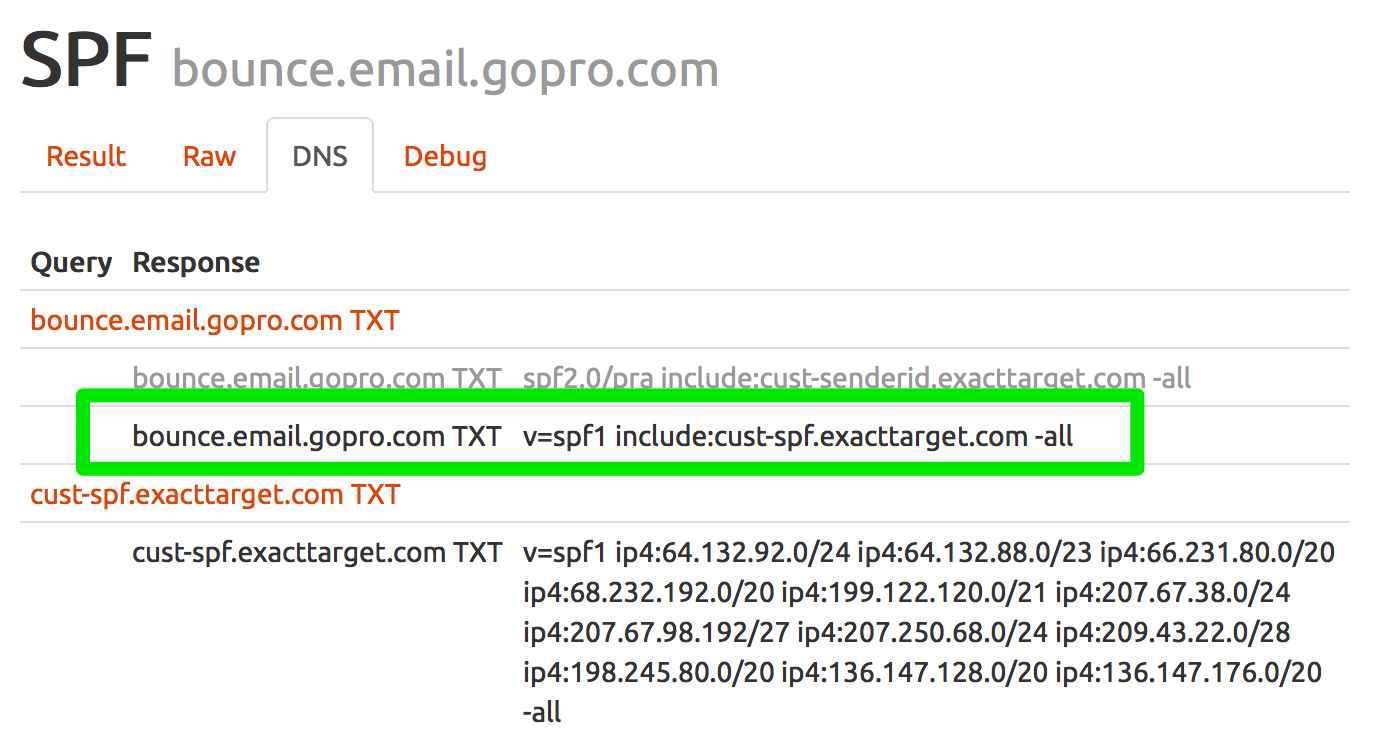
Checking the headers shows that GoPro does have a SPF record setup and the message was authenticated with SPF.![]()
For SPF records, make sure the SPF record matches the Mail From (From.5321)/Return-Path domain name. Have your recipients add the Display From (From.5322) email address to their address book so they will continue to receive your mailings.
Four things to check before your next mailing
Like many bits of technology, email is often set-and-forget. Everything is checked and rechecked during setup, and then no one goes back and looks at it again. But mail programs are not static, and people make changes. These changes don’t really break things, but over time they can create their own set of problems.
Setting aside some time every quarter or even every year to check and make sure all the bits of mail are configured correctly is a good idea.
Office365/EOP IPv6 changes starting today
Terry Zink at Microsoft posted earlier this week that Office365/Exchange Online Protection will have a significant change this week. Office365 uses Exchange Online Protection (EOP) for spam filtering and email protection. One of the requirements to send to EOP over IPv6 is to have the email authenticated with either SPF or DKIM. If the mail sent to Office365/EOP over IPv6 is not authenticated with SPF or DKIM, EOP would reject the message with a 554 hard bounce message. Most mail servers accept the 554 status code and would not retry the message. After multiple 5xx hard bounces to an email address, many mail servers would unsubscribe the user from future email campaigns. The update starting today April 24, will change the error status code for unauthenticated mail to EOP from a 554 hard bounce to a 450 soft bounce and a RFC-compliant and properly configured mail server would then retry the message.
Prior to April 24, 2015, EOP responds to unauthenticated mail with a status code of: “554 5.7.26 Service Unavailable, message sent over IPv6 must pass either SPF or DKIM validation”.
Authentication and Repudiation
Email Authentication lets you demonstrate that you sent a particular email.
Email Repudiation is a claim that you didn’t send a particular email.
SPF is only for email authentication1
DKIM is only for email authentication
DMARC is only for email repudiation
1 SPF was originally intended to provide repudiation, but it didn’t work reliably enough to be useful. Nobody uses it for that now.
March 2015: The month in email
Happy March! We started the month with some more movement around CASL enforcement from our spam-fighting friends to the north. We noted a $1.1 million fine levied against Compu-Finder for CASL violations, as well as a $48,000 fine to Plentyoffish Media for failing to provide unsubscribe links. We noted a few interesting things: the fines are not being imposed at the maximum limits, violations are not just on B2C marketing, but also on B2B senders, and finally, that it really just makes sense — both from a delivery perspective and a financial perspective — to comply with the very reasonable best practices outlined in CASL.
Read MoreBad SPF can hurt your reputation
Can a bad SPF record ruin your delivery, even though all your mail still passes SPF?
Yes, it can.
One of our clients had issues with poor delivery rates to the inbox at gmail and came to us with the theory that it was due to other people using their domain to send spam to gmail. This theory was based on ReturnPath instrumentation showing mail “from” their domain coming from other IP addresses, and a plausible looking correlation between that mail being sent and their problems at gmail.
Checking their bounce handler, we see a lot of bounces coming in suggesting that someone is sending poor quality mail using their bounce domain from quite a few IP addresses, including a suspicious number scattered in small blocks across 69.64.0.0/8.
Their question they had was whether they should publish DMARC records to fix the problem, and whether they should use a DMARC policy of p=reject or p=none. They’re a good candidate for DMARC – their domains are used purely for bulk or transactional mail, they have a tightly controlled mail infrastructure for their marketing domains, and they’re already publishing SPF records and signing all the mail they send with DKIM.
I was half way through writing up my normal answer about DMARC deployment for customers with this sort of mail infrastructure – “It won’t help with delivery problems directly, but publishing with p=none and analyzing the reports you get back will give you insight into your mail flows, and provide the data you need to decide whether using DMARC p=reject is appropriate for your business model and mail flows.” – when I realized that something just didn’t make sense.
Gmail, perhaps more than most other mailbox providers, base their delivery decisions on data they gather mechanically from all their mailboxes. And they really understand domain-based reputation and the difference between authenticated and non-authenticated email. Why on earth would non-authenticated email from an unrelated IP address be damaging the domain reputation, and hence the delivery of authenticated legitimate email? That makes no sense.
Meanwhile, over in our slack channel, Josh was double-checking their infrastructure…

Oops. They have a small block of 8 IP addresses from which they send most of their email. When setting up their SPF records they inadvertently used ip4:69.20.20.48/8 instead of ip4:69.20.20.48/29 for that block of addresses. A /8 isn’t eight IP addresses – it’s every one of the 16,777,216 IP addresses that begins with “69.”.
Suddenly everything makes sense.
The SPF thinko means that all mail claiming to be from the client domain that’s sent from any IP address beginning with “69.” passes SPF – including the deluge of spam coming from the snowshoe spammers in 69.64.*.
Gmail (and other ISPs) don’t see a difference between the legitimate email and the SPF authenticated spam – they’re just seeing a high volume of authenticated email from the client domain, a large fraction of which is spam. That’s damaged the reputation of the client domain, causing their legitimate email to end up in the spam folder.
(The reality of filtering is more than just domain reputation, of course, but a terrible domain reputation is definitely going to cause you problems.)
The immediate action to take is simple – fix the SPF record so only legitimate mail will be authenticated. That’ll take effect within a couple of hours, as the old SPF record has a short TTL, and ISPs will start seeing the correct SPF record and begin rejigging their reputation.
We’ll keep monitoring delivery rates, check how long ISPs take to notice reputation changes, potentially reach out to some ISPs to see if it’s appropriate for them to do a one-time reputation reset for the affected domains, but we’re hoping things will begin to improve in the next few days.
What can you do to avoid or mitigate this sort of problem?
Salesforce SPF and now DKIM support
Salesforce has published a SPF record for sending emails from Salesforce for years and with the Spring ’15 release, they will provide the option to sign with DKIM.
The SPF record is straight forward, include:_spf.salesforce.com which includes _spf.google.com, _spfblock.salesforce.com, several IP address blocks, mx, and ends with a SoftFail ~all.
Salesforce Knowledge Article Number: 000006347 goes in-depth with information regarding their SPF Record.
Email Authentication in a nutshell
 There are 3 types of authentication currently in use for email.
There are 3 types of authentication currently in use for email.
Office365 checking DMARC on the inbound
According to a recent blog post, Office365 is starting to evaluate incoming messages for DMARC. I talked a little bit about DMARC in April when Yahoo started publishing a p=reject message.
Read MoreSpam, Phish or Malware?
Some mornings I check mail from my phone. This showed up this morning.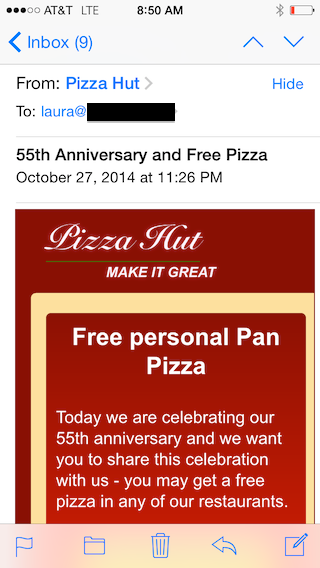
My first thought was “oh, no, Pizza Hut is spamming, wonder who sold them my address.”
Then I remembered that iOS is horrible and won’t show you anything other than the Friendly From and maybe it was some weird phishing scheme.
When I got to my real mail client I checked headers, and sure enough, it wasn’t really from Pizza Hut. I’m guessing actually malware, but I don’t have a forensics machine to click the link and I’m not doing it on anything I can’t wipe (and have isolated from the rest of my network).
The frustrating thing for me is that this is an authenticated email. It not from Pizza Hut, the address belongs to some company in France. Apparently, that company has had their systems cracked and malware sent through them. Fully authenticated malware, pretending to be Pizza Hut, and passing authentication on various devices.
Pizza Hut isn’t currently publishing a DMARC record, but in this case, a DMARC record for Pizza Hut wouldn’t matter. None of the email addresses in the headers point to Pizza Hut.
I spent last week listening to a lot of people discussing DMARC and authentication and protecting people from scams and headers. But those all the protocols in the world won’t protect against this kind of thing. Phishing and malware can’t be fixed by technology alone. Even if every domain on the planet published a p=reject policy, mail like this would still get through.
Authenticating with SPF: -all or ~all
What is SPF?
Sender policy framework (SPF, RFC 7208) is an authentication process that ties the 5321.from (also known as the mail from, envelope from or return path) to authorized sending IP addresses. This authorization is published in a TXT record in DNS. Receivers can check SPF at the beginning of a SMTP transaction, compare the 5321.from domain to the connecting IP address and determine if that IP is authorized to transmit mail.
Read MoreToo much email on the brain
Last night I was cruising through our local news website. I see the headline New SPF guidelines coming our way.
My first thought was, “Wow, SPF made the paper?” Now, I live in the SF Bay area so there are a lot of technology related stories that hit our paper which might not see the light of day in other areas. But, still: new SPF guidelines hit the local paper before I’ve heard about it? That seems a little strange.
Then I notice that it’s in the “Living” section. That’s even stranger.
Oh, well, if there’s new SPF stuff, I’d better click and see what is going on with SPF. The internal headline is Beauty Tuesday: New SPF guidelines accompanied by a picture of sunscreen. It was only then I realized it wasn’t about sender policy framework but was about sun protection.
A bit of a  moment for me.
moment for me.
Happy Friday, everyone.
SPF Fail: too many DNS lookups
I’ve had a couple folks come to me recently for help troubleshooting SPF failures. The error messages said the SPF record was invalid, but by all checks it was valid.
Eventually, we tracked the issue down to how many include files were in the SPF record.
The SPF specification specifically limits the number of lookups that can happen during a SPF check.
Troubleshooting tools
There have been a number of comments on my post about Hotmail moving to SPF authentication having to do with troubleshooting authentication failures. I have been helping clients troubleshoot these issues, and am able to take on new clients to solve authentication problems. Contact me for more information.
Of course, many of these issues can be solved with access to the right tools. Steve’s been working on a number of tools that may help the troubleshooting process and we’ve recently launched them on Emailstuff.org. The website itself contains a number of DNS and data related tools we use for investigations and thought we’d share with the public at large.
One of the really useful tools is the SPF record expander. Plug in any domain, like google.com, and see what IP addresses they authorize to send mail.
Hotmail moves to SPF authentication
Hotmail has recently stopped using Sender ID for email authentication and switched to authenticating with SPF. The protocol differences between SenderID and SPF were subtle and most senders who were getting a pass at Hotmail were already publishing SPF records.
From an email in my inbox from September:
Setting up DNS for sending email
Email – and email filtering – makes a lot of use of DNS, and it’s fairly easy to miss something. Here are a few checklists to help:
Read MoreDMARC: an authentication framework
A new email industry group was announced this morning. DMARC is a group of industry participants, including large senders, large receivers and relevant intermediaries working on a framework to reduce the harm from phishing.
DMARC is working on a standard to allow senders to publish sending policies and receivers to act on those policies. Currently, senders who want receivers to not deliver unauthenticated email have to negotiate private agreements with the ISPs to make that happen. This is a way to expand the existing programs. Without a published standard, the overhead in managing individual agreements would quickly become prohibitive.
It is an anti-phishing technique built on top of current authentication processes. This is the “next step” in the process and one that most people involved in the authentication process were anticipating and planning for. I’m glad to see so many big players participating.
Gmail and the via
I was hoping to have a detailed post up today about the conditions where gmail presents the user with a “via” but time seems to have gotten away from me. But I can give you the conclusions.
Read MoreThe cult of SPF lives
Years ago, prior to the public discussions of Domain Keys, there was SPF as the solution to all our email authentication problems. SPF was going to let people do all sorts of things with email. The proponents even privately asserted that it would solve the spam problem. In essence, SPF was a cult. BoF sessions at meetings had the flavor of a big tent style revival. Those of us who didn’t support SPF were shunned and belittled. How could we not support such a brilliant protocol? Did we want spam to continue being a problem? All our objections no matter how rooted in reality were dismissed out of hand. SPF was an evangelical, cult-like movement.
I am somewhat sad to announce that the cult of SPF still lives. The most recent example is the number of people that have taken me to task for a recent post I wrote pointing out that SPF records aren’t actually that important for email delivery. My example was that a client of mine had incorrect SPF records (with a -all even) but was still getting inbox delivery at Hotmail. We repaired the records, re-registered them with Hotmail and Hotmail not only isn’t checking them but also sent mail to me admitting they don’t check SPF for incoming email.
My statement was that SPF wasn’t really important to getting email delivered. This seems to have upset a number of people. Someone on twitter pointed out that a valid SPF record gave you a positive score with SpamAssassin. What they didn’t mention was that a valid SPF record gives you an entire -0.001 with SpamAssassin.
Today I get a comment from Tom (which seems more like an ad for his company than an actual comment) that says
SPF records: not really all that important
I’ve been working through some Hotmail issues with a client over the last few months. One of the things that has become clear to me is how little Hotmail actually does with SPF records. In fact, Hotmail completely ignored my client’s SPF record and continued to deliver email into the inbox.
This isn’t just a sender that had a “well, we think most of our email will come from these IPs but aren’t telling you to throw away email that doesn’t” record. In fact, this client specifically said “if email doesn’t come from this /28 range of email addresses, then it is unauthorized and should be thrown away.” The email was being sent from an IP outside of the range listed in the SPF record.
As part of the process involved in fixing the delivery problems, I had the client update their SPF record and then I enrolled their domain in the SenderID program at Hotmail. This didn’t have any effect, though. Hotmail is still not checking SPF for this client. When I asked Hotmail what was going on they said, “We do not do lookups on every sender’s mail.”
So, there you have it folks. The last bastion of SPF/SenderID has abandoned the technology. Even a totally invalid SPF record doesn’t matter, mail can still reach the inbox at Hotmail.
ESPs, Non-portable Reputation and Vendor Lock-in
I’ve seen some mentions recently of ESPs suggesting that if you use your own domain in the From: of mail you send through an ESP then that ESP can’t “do email authentication” properly unless they require you to edit your domains DNS settings. That’s not really so, but there is a kernel of truth in there.
The real situation is, unsurprisingly, a bit more complicated.
What authentication features should you look for in an ESP?
Who can you trust?
I’ve been recently dealing with a client who is looking at implementing authentication on their domains. He’s done a lot of background research into the schemes and has a relatively firm grasp on the issue. At this point we’re working out what policies he wants to set and how to correctly implement those policies.
His questions were well informed for the most part. A few of them were completely out of left field, so I asked him for some of his references. One of those references was the EEC Email Authentication Whitepaper.
My client was doing the best he could to inform himself and relies on industry groups like the EEC to provide him with accurate information. In this case, their information was incomplete and incorrect.
We all have our perspectives and biases (yes, even me!) but there are objective facts that can be independently verified. For instance, the EEC Authentication whitepaper claimed that Yahoo requires DKIM signing for access to their whitelist program. This is incorrect, a sender does not have to sign with DKIM in order to apply for the Yahoo whitelist program. A bulk sender does have to sign with DKIM for a Y! FBL, but ISPs are given access to an IP based FBL by Yahoo. I am shocked that none of the experts that contributed to the document caught that error.
Independent verification is one reason I publish the Delivery Wiki. It’s a resource for everyone and a way to share my knowledge and thought processes. But other experts can “check my work” as it were and provide corrections if my information is outdated or faulty. All too often, senders end up blaming delivery problems on evil spirits, or using “dear” in the subject line or using too much pink in the design.
Delivery isn’t that esoteric or difficult if you have a clear understanding of the policy and technical decisions at a range of ESPs and ISPs, the history and reasoning behind those decisions, and enough experience to predict the implications when they collide.
Many senders do face delivery challenges and there is considerable demand for delivery experts to provide delivery facts. That niche has been filled by a mix of people, of all levels of experience, expertise and technical knowledge, leading to the difficult task of working out which of those “experts” are experts, and which of those “facts” are facts.
How to disable a domain
Sometimes you might want to make it clear that a domain isn’t valid for email.
Perhaps it’s a domain or subdomain that’s just used for infrastructure, perhaps it’s a brand-specific domain you’re only using for a website. Or perhaps you’re a target for phishing and you’ve acquired some lookalike domains, either pre-emptively or after enforcement action against a phisher, and you want to make clear that the domain isn’t legitimate for email.
There are several things to check before disabling email.
1. Are you receiving email at the domain? Is anyone else?
Check the MX records for the domain, using “host -t mx example.com” from a unix commandline, or using an online DNS tool such as xnnd.com.
If they’re pointing at a mailserver you control, check to see where that mail goes. Has anything been sent there recently?
If they’re pointing at a mailserver that isn’t yours, try and find out why.
If there are no MX records, but there is an A record for the domain then mail will be delivered there instead. Check whether that machine receives email for the domain and, if so, what it does with it.
Try sending mail to postmaster@ the domain, for instance postmaster@example.com. If you don’t get a bounce within a few minutes then that mail may be being delivered somewhere.
2. Are you sending email from the domain? Is anyone else?
You’re more likely to know whether you’re sending mail using the domain, but there’s a special case that many people forget. If there’s a server that has as it’s hostname the domain you’re trying to shut down then any system software running no that server – monitoring software, security alerts, output from cron and so on – is probably using that hostname to send mail. If so, fix that before you go any further.
3. Will you need mail sent to that domain for retrieving passwords?
If there are any services that might have been set up using an email address at the domain then you might need a working email address there to retrieve lost passwords. Having to set email back up for the domain in the future to recover a password is time consuming and annoying.
The domain registration for the domain itself is a common case, but if there’s any dns or web hosting being used for the domain, check the contact information being used there.
4. How will people contact you about the domain?
Even if you’re not using the domain for email it’s quite possible that someone may need to contact you about the domain, and odds are good they’ll want to use email. Make sure that the domain registration includes valid contact information that identifies you as the owner and allows people to contact you easily.
If you’re hosting web content using the domain, make sure there’s some way to contact you listed there. If you’re not, consider putting a minimal webpage there explaining the ownership, with a link to your main corporate website.
5. Disabling email
The easiest way to disable email for a domain is to add three DNS records for the domain. In bind format, they look like:


